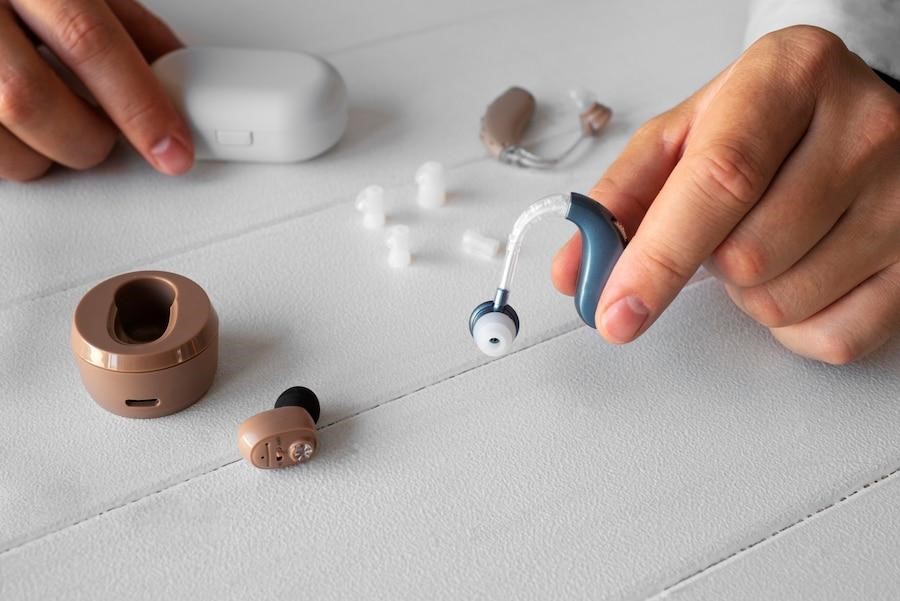The Evolution Of Hearing Aids: From Analog To Digital, Exploring Modern Options

The evolution of hearing aids has been remarkable, from clunky analog devices to sleek digital marvels. This article will explore their journey from rudimentary beginnings to sophisticated solutions available today.
Join us as we uncover key milestones and breakthrough innovations shaping modern hearing aids. We’ll delve into the transition from analog to digital technology, highlighting the benefits and advancements revolutionizing the industry.
Whether you are considering a hearing aid for yourself or a loved one or are intrigued by the latest technological developments, this article offers valuable insights. Discover how cutting-edge devices transform the lives of those with hearing loss and experience improved hearing firsthand.
The History Of Hearing Aids
The history of hearing aids dates back centuries, with early attempts at amplifying sound seen in the 17th century through devices like ear trumpets. However, these early tools could have been more effective at isolating specific frequencies.
In the late 19th century, electric hearing aids emerged, employing carbon microphones to convert sound into electrical signals. Despite this advancement, these devices remained bulky and uncomfortable.
By the mid-20th century, analog hearing aids became prevalent, utilizing transistors for sound amplification. Though smaller and more portable, they still struggled with sound quality and customization, often amplifying all sounds evenly.
Analog Hearing Aids And Their Limitations
While an improvement, analog hearing aids had notable limitations affecting user experience. They struggled to differentiate between sound frequencies, hindering speech comprehension in noisy settings. Additionally, they lacked automatic adjustment to different environments, requiring manual tuning and offering limited customization options for specific hearing needs.
Despite these drawbacks, analog aids remained the primary option for decades until the emergence of digital hearing aids, a groundbreaking innovation poised to revolutionize hearing aid technology.
The Advent Of Digital Hearing Aids
Digital hearing aids revolutionized the industry, offering unmatched benefits over analog devices. By converting sound into digital signals, they allowed precise amplification and customization.
Their real-time sound processing adjusts amplification to suit the wearer’s unique needs, enhancing speech understanding and reducing background noise. Directional microphones selectively capture sound, improving hearing in noisy environments.
Benefits Of Digital Hearing Aids
Digital hearing aids offer more than just improved sound quality and customization. They provide various features that enhance the user experience. For instance, they can wirelessly connect to other devices via Bluetooth, allowing wearers to stream audio directly from smartphones, TVs, and other compatible devices. This seamless listening experience eliminates the need for additional accessories.
Additionally, Bluetooth connectivity enables remote control of hearing aids, facilitating easy adjustment of settings and volume levels.
Moreover, digital hearing aids incorporate artificial intelligence (AI) technology, learning and adapting to the wearer’s preferences and listening environments over time. These AI-powered devices automatically adjust settings based on the wearer’s habits and offer personalized sound profiles for different situations.
Modern Options In Hearing Aid Technology
Modern digital hearing aids offer a range of customizable features tailored to individual needs. These include rechargeable batteries, eliminating the need for frequent replacements, and tinnitus masking to soothe ringing sensations. Smartphone apps allow wearers to control and adjust settings directly. Advanced feedback cancellation reduces unwanted sounds, and environmental adaptation automatically optimizes settings for different situations.
Wireless And Bluetooth Connectivity In Hearing Aids
Wireless and Bluetooth connectivity have revolutionized how people with hearing loss use devices. With wireless connectivity, users can connect their hearing aids to smartphones, tablets, or TVs, enabling seamless audio streaming. This means they can make calls, watch TV, or listen to music directly through their hearing aids without extra accessories.
Bluetooth connectivity allows users to control their hearing aids remotely. Smartphone apps from hearing aid makers let users adjust volume, change programs, and access personalized sound profiles for different environments. This control empowers users to optimize their hearing experience instantly.
Artificial Intelligence In Hearing Aids
Artificial intelligence has revolutionized hearing aids, turning them into intelligent devices that cater to the wearer’s preferences and adapt to their needs. AI-powered hearing aids employ machine learning algorithms to analyze the wearer’s listening habits, preferences, and surroundings.
These advanced hearing aids continuously learn from the wearer’s interactions, automatically adjusting settings for optimal performance. They can discern speech from background noise, suppress unwanted sounds dynamically, and enhance speech clarity in challenging environments. This adaptability and intelligence give wearers a more natural and personalized hearing experience.
Customizable Features In Modern Hearing Aids
Today’s digital hearing aids are equipped with customizable features designed to meet individual needs, enhancing their effectiveness across various listening environments. One notable advancement is personalized sound profiles, which allow users to fine-tune frequency response, volume levels, and other parameters through smartphone apps or control accessories. These personalized adjustments optimize the hearing aids to suit each individual’s unique hearing preferences and environments.
Additionally, advanced feedback cancellation algorithms incorporated into modern hearing aids significantly minimize unwanted noise, ensuring wearers experience clear, comfortable sound quality. Consulting with audiology experts can further guide individuals in harnessing these customizable features to maximize the benefits of their hearing aids for improved auditory experiences.
Conclusion: The Future Of Hearing Aids
The move to digital hearing aids has transformed the experience for hearing loss patients. These smaller, more comfortable devices offer improved sound quality and customization. Digital aids now come with wireless connectivity, artificial intelligence, and customizable features for better usability.
Looking forward, advancements promise smaller hearing aids with expanded connectivity and advanced AI, seamlessly integrating them into daily life to enhance overall well-being.
For those considering aids, now is an exciting time. Digital technology has improved aids’ effectiveness and user-friendliness. Explore modern options and embrace the potential of better hearing. Remember, the journey to improved hearing starts with exploring modern aid technology.